One thing’s certain, modern rock music as we know it today just wouldn’t be the same without Jack White. Just around a time when rock and roll seemed to be missing a performer that was new and innovative, out came Mr. White as rock music’s hidden ace up its sleeve and took things to a new level. It’s not often you meet an adult who hasn’t heard of Jack White. And even those who don’t recognize his name will almost certainly recognize the song “Seven Nation Army.”
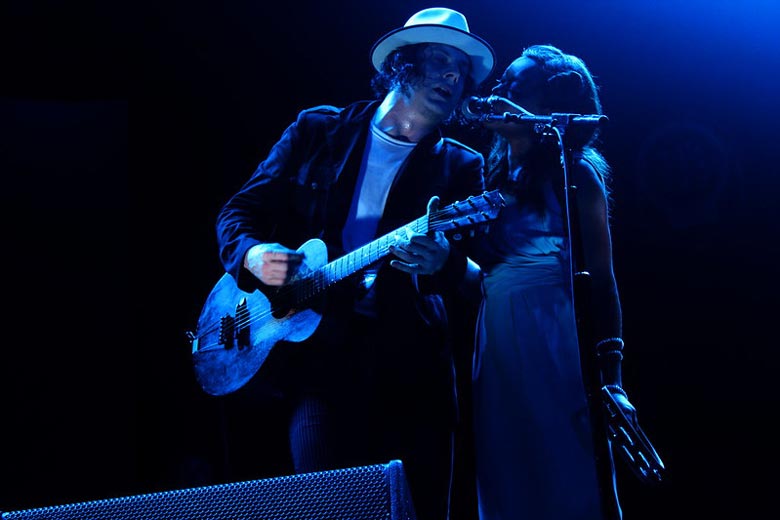
Jack White is also well known for his gear and how innovative he is at implementing it into his sound. Although keeping things somewhat simple when it comes to his rigs, there are some pretty interesting components. One of the most exciting is obviously the guitars that he uses. He’s been known for using some vintage and oddball guitars throughout his career, although over the past few years he has used some incredible modern models. Definitely some “unexpected” guitars or at least something you wouldn’t expect from Jack White.
What Guitar Does Jack White Play?
Jack White is most known for playing a red 1964 Airline guitar. In more recent years he’s primarily used several customized Fender Telecasters as well as EVH Wolfgang Custom guitars.
He has also used many other guitars for his solo albums as well as work with bands such as The Raconteurs over the years. See the full list of the most notable Jack White guitars below.
1964 Airline JB Hutto Montgomery
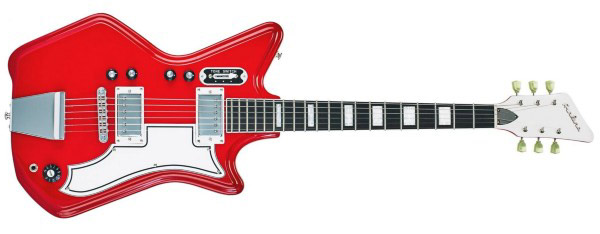
Years Used: 2000s to Present
Finish: Red
Overview: One of Jack White’s most important instruments, and the one that he used extensively during his time with The White Stripes, 1964 Airline JB Hutto is one of the most unique-looking models ever made. What’s interesting is that this instrument, made back in 1964, wasn’t exactly an exclusive one. Made by a company called Valco and under the Airline brand, they didn’t have an actual model name. What’s interesting is that these had a fiberglass hollow body and a maple block in the center. They came with two single-coil pickups, which are these days often mistaken for humbuckers. This one also came with a Tune-o-Matic bridge and tailpiece and they also lacked a truss rod.
Although a pretty unusual model with a lack of some important features that we’re used to, as well as a very unusual body shape, it was more than enough for Jack, both aesthetically and performance-wise. Needless to say, after Jack’s rise to fame, a lot of young guitarists got interested in this particular design. One thing led to another, and Eastwood Guitars began producing this model under the Airline brand. However, these guitars are made out of mahogany, but they still have that fun design and they work pretty well.
Kay Hollow-Body Guitar from the 1950s
Years Used: 2001 to Present
Finish: Kraft paper (originally presumed to be tobacco sunburst)
Overview: With his inclination to use vintage gear, it’s only obvious to see Jack White using a guitar like his Kay hollow-body archtop from the 1950s, which he got from one of his friends. Presumed to be a K6533 Value Leader model, it originally had a sunburst finish but Jack covered it with kraft paper. This is far from a top-tier guitar, although Jack found a good use for it, recording The White Stripes’ “Seven Nation Army” on it by also using DigiTech’s legendary Whammy pedal (but we’ll get to that later). It features a spruce top, maple sides and back, a rosewood bridge, and one DeArmond pickup with only one on and off switch.
These have never really been favored vintage guitars. But after Jack recorded “Seven Nation Army” and a few other big hits on it, we saw the rise in interest for old Kay hollow-body guitars. Nonetheless, they still retain some pretty reasonable prices among collectors, especially compared to other guitars from the 1950s.
Gibson L-1 From 1915
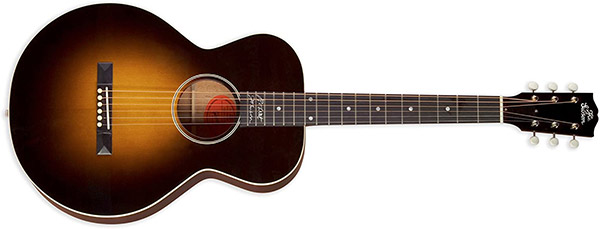
Years Used: 2000 to Present
Finish: Natural finish
Overview: For this one, we would have to go all the way back to 1915. Gibson’s L-1 is also the same model used by none other than Robert Johnson back in the day. Although the guitar model is often referred to as the “Robert Johnson” one, these “signature” guitars only came out in more recent years.
With a guitar that’s this old, it’s pretty clear how fond Jack is of vintage stuff. These guitars have originally been produced from 1902 and up to 1937. It features a body made of birch, while the neck is a mahogany one. You can hear this old instrument on a song like “Icky Thump.” But what’s pretty interesting is that he used a pickup attached to it in order to achieve the tone of an electric hollow-body guitar.
Gretsch G6199 Billy-Bo Jupiter Thunderbird

Years Used: 2007 to Present
Finish: Gloss Urethane, White
Overview: According to Jack White, he painted this guitar white while collaborating with Alicia Keys. Originally, this guitar had a regular red finish, but he puts more importance into the whole aesthetic aspect of things. During the live performances, Jack White used it for the James Bond theme, the “Another Way to Die” song.
This model, which is also used by ZZ Top frontman Billy Gibbons, features a body made out of laminated maple and mahogany. The unusual shape not only brings a very unique and aesthetically pleasing look to it but also makes it fairly comfortable to play. This is all accompanied by a mahogany neck with a rosewood fretboard featuring 22 frets. The Tune-o-Matic bridge is fitted onto an ebony base and strings go to Gretsch’s own G-Cutout tailpiece. The guitar is armed with two TV Jones Power’Tron humbucking pickups and has two volume controls and one tone knob. It was originally designed by Bo Diddley himself (as you can notice by the model’s name) back in the late 1950s.
Gretsch G6022 Rancher
Years Used: 2005 to Present
Finish: White with custom engravings on the back
Overview: When it comes to acoustic guitars, Jack White also prefers Gretsch stuff. With its amazing aesthetic features and great performance qualities, the G6022 Rancher Falcon is one of the models that White is remembered for. At the same time, this is also one of Gretsch’s most famous acoustic models.
The instrument’s widebody brings a pretty loud and resonant tone, slightly pronouncing high-ends in the mix. The model also has a pretty interesting triangular soundhole and a specially designed cutaway. The instrument also comes with an internal preamp and a piezo pickup system. He has a couple of these, one of which is white and the other one with an interesting shade of orange. Both of these instruments have specially designed engravings on the backside.
Gibson EDS-1275 Jimmy Page Signature
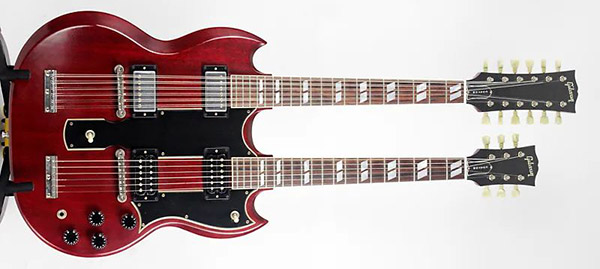
Years Used: 2000s to Present
Finish: Red
Overview: Although Jack White didn’t quite use this guitar, Gibson EDS-1275 is most definitely present in his collection. This is the legendary model, popularly used by Jimmy Page and John McLaughlin back in the days, and was also released as a Jimmy Page signature guitar. It rocks that double-neck design with one 6-string and one 12-string guitar fused into one instrument.
Relying on the classic SG design, it bears a thin and light mahogany body, as well as a mahogany neck and a rosewood fretboard. The instrument’s design is followed by celluloid split parallelogram inlays on the fretboard and binding all throughout the neck’s length. It also comes with Tune-o-Matic bridges and nickel tailpieces, ensuring stable performance and great sustain. Both of the sections feature two Gibson-made humbucking pickups and one set of controls, along with a switch that lets you choose between two of the guitar’s sections.
Crestwood Astral II
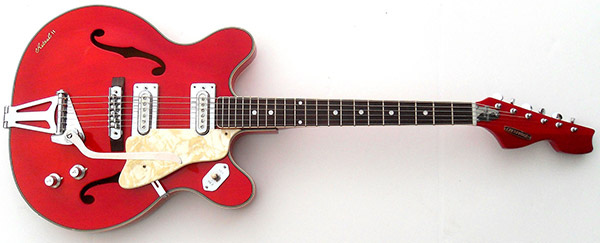
Years Used: 2003 to Present
Finish: Red
Overview: The Crestwood Astral II guitar is a pretty rare one. Jack used this semi hollow-body from The White Stripes’ earliest days. Along with his Airline, Crestwood Astral II is one of the most important “weapons” in his arsenal. The instrument bears a body design somewhat similar to Gibson’s 335, while the headstock is visibly inspired by Fender guitars. The instrument itself was made in Japan and has plywood as the main material. Meanwhile, the bridge is a standard Tune-o-Matic one although it’s placed on a wooden base. This is all accompanied by a Bigsby-inspired tailpiece and whammy bar.
This guitar, which bears two simple single-coil pickups and basic controls, usually had the open E tuning. With such a setting, Jack White used it for songs with slide guitar parts. As is the case with some other guitars, this one also became more popular among collectors after Jack White gave it a spotlight.
Danelectro Doubleneck Baritone
Years used: 2002 to Present
Finish: Off White
Overview: There’s just something so mysterious about Danelectro guitars. Sure, we’re aware of them, but they seem to pop up in many famous guitarists’ inventories even though they’re somewhat rare. As far as Jack’s collection goes, he has one Danelectro Doubleneck guitar in there, although he hasn’t used it that often throughout the years.
But compared to “regular” double-neck guitars (as if they’re not outlandish already by default), this one comes with two 6-string necks. The only difference here is that one features a pretty much standard scale length, while the other guitar here has a baritone scale length. It’s not certain which exact model is this guitar. And knowing what Jack is like, the instrument seems to have been redone way back in The White Stripes days.
Each of the guitar segments comes with two “lipstick” single-coil pickups and 3-way switches. There’s also a switch that lets you pick between two guitars. The baritone neck with its longer scale length allows him to tune down lower, presumably down to B standard. And although the instrument features single-coils, it can achieve some “beefiness” in the tone, especially when paired with tube amps and some fuzzy distortion pedals in his signal chain.
Related Article: Billie Joe Armstrong Guitars and Gear List
Gretsch Anniversary Triple Green Machine
Years Used: 2006 to Present
Finish: White
Overview: Interestingly enough, Jack White’s famous Green Machine is not green but white. But anyway, this guitar by Gretsch is more than just a simple instrument that one would think of. This particular guitar was built by Randy Parsons who is Jack White’s favorite luthier. Although working for Gretsch, Parsons made this guitar in direct collaboration with Jack.
This one is a double-cutaway instrument with a semi-hollow body. But aside from some expected features, such as its amazing-looking F-shaped soundholes, the instrument also had a Shure Green Bullet built into it. The instrument also comes with a Bigsby tremolo system, a mute system (which dampens the strings), and even an integrated theremin. The theremin is activated by moving your hand away from the bridge. As you can see, Jack’s creativity is pretty obvious with this instrument. And as if all of this wasn’t enough, the guitar also comes with three humbucking pickups and an abundance of tone-shaping controls. You just won’t find any guitar out there that’s like his Triple Green Machine.
Fender Highway One Telecaster
Years Used: 2010 to Present
Finish: Light blue
Overview: While we don’t exactly imagine Jack White holding a Telecaster guitar, he actually has a pretty nice one in his collection. Those who know and who have seen his video for “Freedom at 21” are familiar with it. Bearing a designated model name Highway One Telecaster, this one, just like most of Jack’s guitars, has its own special modifications. Instead of a standard bridge, the guitar comes with a Bigsby-style tremolo tailpiece, in combination with a Tele bridge.
But other than that, it’s pretty much what you’d expect of a Telecaster. The stylish body finishes accompanied by a maple neck and a maple fretboard, as well as two single-coil pickups and standard Telecaster controls. One exciting aesthetic feature is that most of its hardware is white, giving it a rather unique look along with the instrument’s light blue finish.
National Style 1 Tricone
Years Used: 2014 to Present
Finish: Polished metal body
Overview: Resonator guitars truly have a purpose of their own among guitar players. Although not using it that often, Jack White has National Style 1 Tricone acoustic guitar. This prestigious high-end instrument has a completely brass body, giving it not only a louder output but also a way to cut through the mix more easily. Of course, you can hear a noticeable accent on the mids and high-ends with such an instrument.
But such a body is accompanied by a nice mahogany neck, as well as an ebony fretboard. What’s more, the fretboard features ivory binding all throughout its length, rounding up its already impressive design. You don’t often see an instrument like this one, and it clearly shows Jack White’s refined taste in guitars.
Ernie Ball Music Man St. Vincent Signature
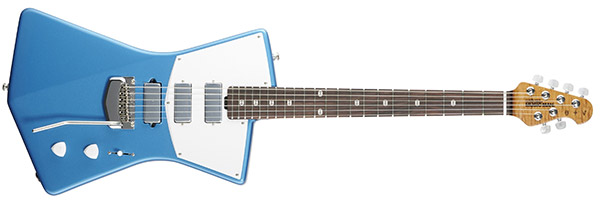
Finish: Blue
Years Used: 2012 to Unspecified
Overview: We don’t often see a famous musician rocking out on another one’s signature instrument. However, Ernie Ball Music Man St. Vincent’s signature guitar seems to be a pretty great choice for Jack White, both in terms of aesthetics and its performance characteristics. This particular instrument bears a pretty unique body shape, kind of resembling Glenn Tipton’s Hamer GT.
St. Vincent’s signature model comes with a mahogany body and maple neck, as well as three mini-sized DiMarzio humbucking pickups. Aside from volume and tone knobs, there’s a 5-way switch, allowing for some more tone-shaping features than usual for a guitar with humbuckers. With a special custom-made tremolo bridge and amazing Shaller locking tuners, this instrument performs as well as any other shred tool out there. But at the same time, it fits Jack White’s unique alt-rock style.
Gibson Firebird Skunk Baxter Signature

Finish: Copper metallic
Years Used: 2017 to Present
Overview: And yet another signature guitar in his collection, Jack White has a Gibson Firebird Skink Baxter model. Although we’re all familiar with Firebird guitars, which are is of those “offset” Gibson models, this one is a bit weirder, making it perfect for a musician like White. The first noticeable thing is its copper metallic finish and a stunning Lyre vibrato tailpiece. This one has a body made out of mahogany and a neck that’s a combo of mahogany and walnut with a rosewood fingerboard on it.
When it comes to the pickups, the instrument comes with three ’57 humbuckers. But things get rather weird when we take a look at its controls. Of course, we have the volume and tone controls. However, additional features for individual pickup switching, as well as coil splitting, make it an extremely versatile one.
Daddy Mojo Cigar Box
Years Used: 2013 to Present
Finish: Black
Overview: Going deeper into Jack’s weird collection, we can also find a rather unusual but pretty useful and unique Cigar Box guitar made by Daddy Mojo. The company has been around for a while and they make both DIY kits and fully assembled cigar box guitars. What’s pretty great here is that these are not expensive instruments, something that Jack likes to experiment with. These are all hand-made in Montreal, Canada, and all utilize a pretty simple construction. The specs usually vary and things are not as consistent in their production, although that’s their whole point – to give players a legitimate one-of-a-kind instrument.
As far as Jack White’s Cigar Box guitar goes, it’s not certain which components are included here and what he actually has going on in there. What’s certain is that he prefers to play this cute black guitar with a slide. It’s nothing spectacular but works pretty well in his hands.
EVH Wolfgang Edward Van Halen Signature
Years Used: 2010s to Present
Finish: Satin urethane stealth black
Overview: The entire guitar world was baffled when Jack White started playing an EVH Wolfgang Custom, one of Eddie Van Halen’s specially designed signature guitars. Sure, everyone’s free to play what they want, but you don’t often see a bluesy alternative rock player holding a real shred machine designed by Eddie Van Halen. This absolute beauty, featuring a black satin finish, feels pretty easy to play, and that’s exactly what prompted Jack to get his hands on one of these.
This impeccably designed instrument has a basswood body with a very ergonomic double-cutaway shape, as well as a headstock that keeps stings in a straight line with the rest of the neck. It’s also armed with an EVH branded Floyd Rose Tremolo that also comes with a so-called “D-Tuna” feature. It also comes with special Wolfgang Alnico pickups, volume and tone controls, a 3-way pickup selector switch, as well as a red-colored killswitch button. It seems that Jack White is always keen on pushing the boundaries in any way he can.
Fender Custom Shop Acoustasonic Telecaster
Years used: 2019 to Present
Finish: Orange
Overview: Right when everyone thought that there just aren’t any more exciting new things that you can do with guitars, Fender came out with their amazing Acoustasonic series. These instruments basically mimic the classic solid-body electric guitar shapes that Fender is known for, although they’re thin-bodied acoustic guitars. Nonetheless, they also come with both piezo and magnetic pickups, allowing you to use them as regular electric guitars.
While we’re at it, Jack White is the first musician that got one of these made especially for him in Fender’s Custom Shop. The model in question is a Telecaster and it features a completely hollow body with a spruce top and mahogany back and sides. It features a rather interesting shade of orange as its finish, something that fits Jack’s aesthetic requirements. As far as the neck goes, it’s a mahogany one with an ebony fretboard
This guitar features one single-coil magnetic pickup, the N4 Noiseless model located in the bridge position. Then there’s also a piezo pickup by Fishman under the saddle, as well as another Fishman piezo, the Enhancer Body Sensor which is located in the middle position. It’s a rather unusual combination that also comes with a 5-way switch and a mod knob that lets you blend between magnetic and piezo tones. Meanwhile, the selector switch lets you choose five different “voices” rather than regular pickup combinations. Fender truly outdid themselves and you don’t find such guitars anywhere.
Related Article: Guitars Used by Kurt Cobain
Fender Custom B-Bender Telecaster
Years used: 2019 to Present
Finish: Lowrider Metallic Orange
Overview: Another spectacular guitar by Fender in Jack White’s collection, this unique Telecaster “screams” his name. It takes no more than a glance to realize that it’s his instrument. Also bearing an orange finish, this is yet another instrument that came out of Fender’s Custom Shop. And this is, once again, not an ordinary solid-body electric guitar. The instrument comes with the so-called B-Bender feature, something that comes as a vintage feature and that brings us back to the old days.
The B-Bender system is pretty much self-explanatory – it bends the B string. However, the feature that raises the string’s pitch up to three semitones includes a rather delicate mechanism packed in the guitar’s backside. However, that’s not all. The instrument also has a specially designed Hipshot bridge that features three levers. These mechanical controls let you raise the pitch of E and G strings, while the third lever drops the E string one whole note down to D. However, Jack keeps modifying it and has now removed the E bender lever to have more maneuverability with his picking hand.
While this Telecaster has standard build qualities that you’d expect, including a maple neck with a maple fretboard, its pickups and electronics are different. In the bridge position, we have a Lace Sensor single-coil, a P-90 single-coil in the middle, and a Thinline humbucker, presumably a Wide Range Humbucker. Along with its controls, this guitar allows a pretty versatile palette of tones. As you can clearly see, this is a pretty unique instrument, something that Jack White prefers.
Table Showing What Guitars Jack White Used at Each Point of His Career
| Make | Model | Color/Finish | Years |
|---|---|---|---|
| Airline | Res-o-glass "JB Hutto" | Red | 2000s-Present |
| Kay | Hollow-Body | Kraft paper | 2001-Present |
| Gibson | L-1 (from 1915) | Natural | Early 2000s - Present |
| Gretsch | G6199 | White | Late 2000s-Present |
| Gretsch | G6022 | White | Mid 2000s - Present |
| Gibson | EDS-1275 (Jimmy Page Signature) | Red | Mid 2000s-Present |
| Crestwood | Astral II | Red | Early 2000s-Present |
| Danelectro | Doubleneck Baritone | offwhite | 2000s-Present |
| Gretsch | Triple Green Machine | White | Late 2000s-Present |
| Fender | Highway One Telecaster | Light Blue | Early 2010s-Present |
| National | Style 1 Tricone | Polished Metal | Mid 2010s-Present |
| Ernie Ball Music Man | St. Vincent Signature | Blue | Late 2010s |
| Gibson | Firebird Skunk Baster Signature | Copper Metallic | Late 2010s-Present |
| Daddy Mojo | Cigar Box | Black | Mid 2010s |
| Fender | Acoustasonic Telecaster | Orange | 2019-Present |
| Fender | B-Bender Telecaster | Orange | 2019-Present |
| EVH Wolfgang | USA Eddie Van Halen Signature | Stealth Black | 2018-present |
Amps and Other Jack White Gear
Sears Silvertone 1485 Six Ten
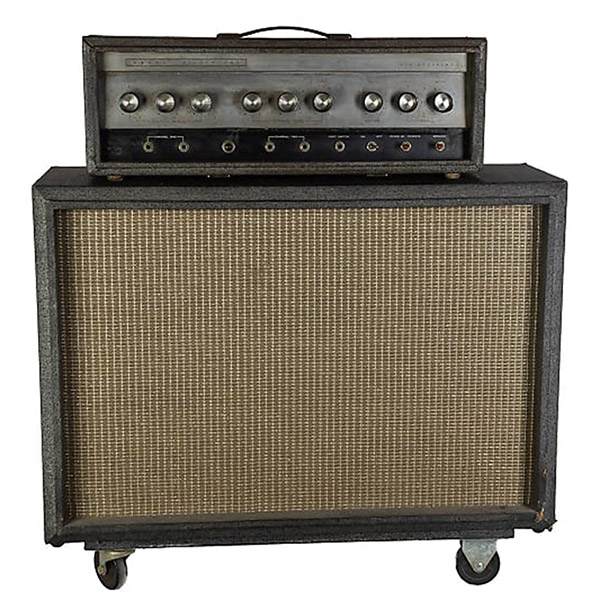
Years Used: Early 2000s to Present
Overview: Just like he’s really into vintage guitars, the same could be said about Jack’s choice of guitar amps. For many years, he has used an old legendary Silvertone 1485 model. This is a 120-watt tube amp head with a separate cabinet, featuring six 10-inch speakers in it. This amp was designed by Danelectro and was distributed by Sears. Interestingly enough, it has been sold for only a short 3-year window back in the 1960s, making it a pretty rare specimen. But for its time, this was a pretty innovative and versatile amp, giving you tremolo and reverb effects, along with a footswitch.
As far as its insides go, it features no less than 10 tubes and 5 rectifiers. It’s usually really hard to find more detailed specs about this amp, mostly due to being a pretty rare one. But what’s certain is that it brings that vintage powerful tube-driven output with that natural “crunch” in the mix – something that Jack White loves and something that worked perfectly for The White Stripes.
Fender ’65 Twin Reverb
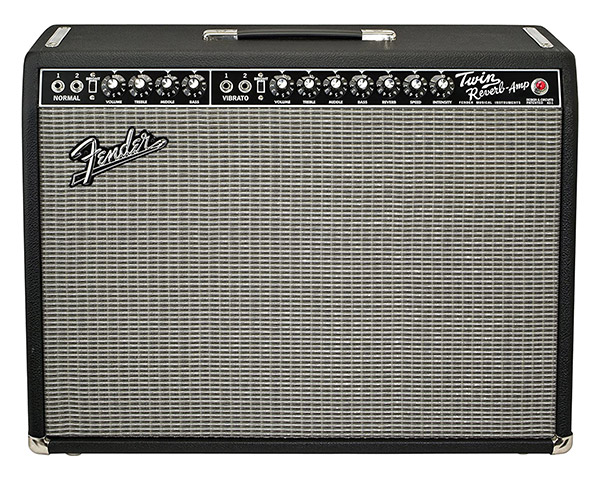
Years Used: Early 2000s to Present
Overview: Another very important amp in Jack White’s powerful arsenal is his Fender ’65 Twin Reverb. This is a classic legendary amp used by many other guitar greats. What’s pretty interesting is that Jack never used Silvertone’s built-in reverb, but rather preferred to use this particular model for those tones.
The amp model goes all the way back to the 1950s and has been reissued in the 1990s. The amp, which is still produced to this day, features two channels, 85 watts of power, two 12-inch speakers, as well as vibrato and reverb effects. The effects are accessible through its second channel, although both of them have the “bright” switch that adds some sparkling high-ends. It’s packed with four 12AX7 tubes and two 12AT7 ones in the preamp section, while the power amp has four 6L6 output tubes. It has that classic “American” tone with slightly “scooped” mids and pronounced bottom-ends.
Fender Twin from 1950s
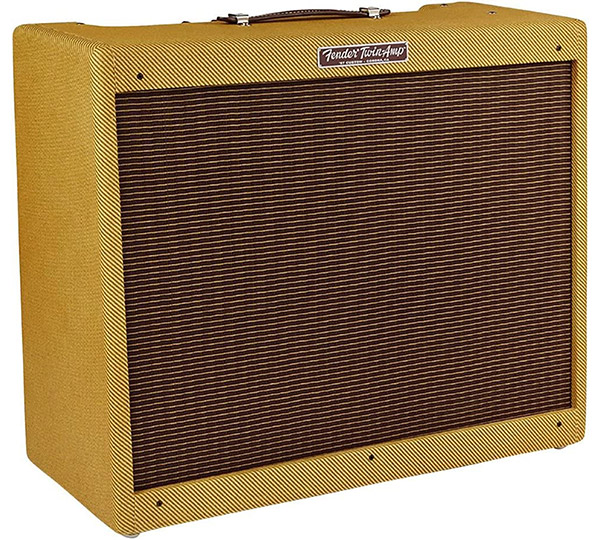
Years Used: Late 2000s to Present
Overview: By now, we’ve seen how much Jack loves his vintage-oriented stuff. In his collection, there’s also an old Fender Twin amp from the 1950s, although the exact year of production has not been confirmed. These are the so-called “Tweed” amps, providing that super “twangy” bright tone that lovers of old school blues and rock music prefer.
Just like newer Fender Twin amps, these also had two 12-inch speakers. The power amp also has that classic choice of 6L6 vales for the traditionally “American” tone. It’s just an obvious choice for a player like Jack White.
Fender Bassman AB165
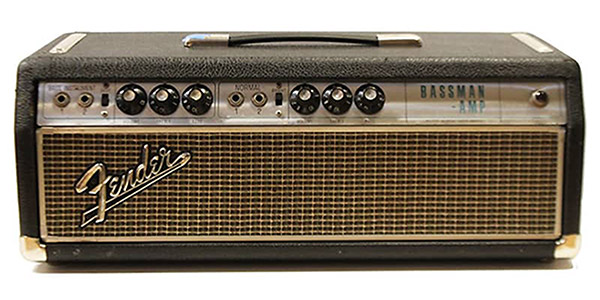
Years Used: Early 2000s to Present
Overview: Going deeper into his collection, we can find yet another old school Fender amp, the AB165 Bassman. Even to this day, old Bassman heads retain their popularity and value among avid vintage collectors.
Originally intended only for bass guitars, these amplifiers have been proven to do wonders for one’s tone, adding that immense yet controlled punch in the bottom-ends. What’s more, the AB165 is a slightly “dirtier” model, giving less headroom compared to other examples from this line of amps. Once again, we have a traditionally “American”-sounding amp, which clearly shows a pattern here.
Pedals Used by Jack White
DigiTech Whammy
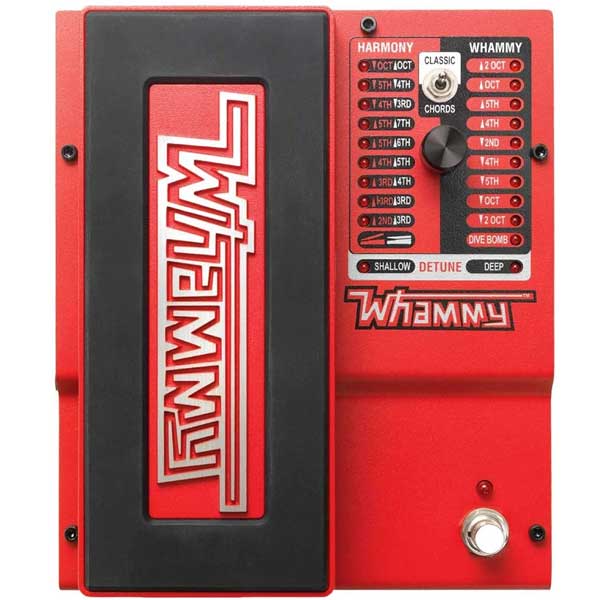
Years Used: Early 2000s to Present
Overview: If there wasn’t for DigiTech’s unique Whammy pedals, things just wouldn’t be the same in rock music. One of the most famous of its uses is in The White Stripes’ “Seven Nation Army” where Jack White paired it up with his old Kay semi-acoustic and dropped it down an octave in order to achieve that muffled bass tone. The Whammy pedal is one of the best-known pitch-shifter devices in the world of guitar. Jack White has a few versions in his collection, including the first generation from the early 1990s and the Whammy DT version.
But no matter the version that we’re talking about, they all rely on the same basic principles. Just like you’d rock the wah pedal, the Whammy actively changes the pitch according to the set parameters and sensitivity. The most exciting part is that you can get these in pretty much any standard guitar store.
Electro-Harmonix Big Muff Pi
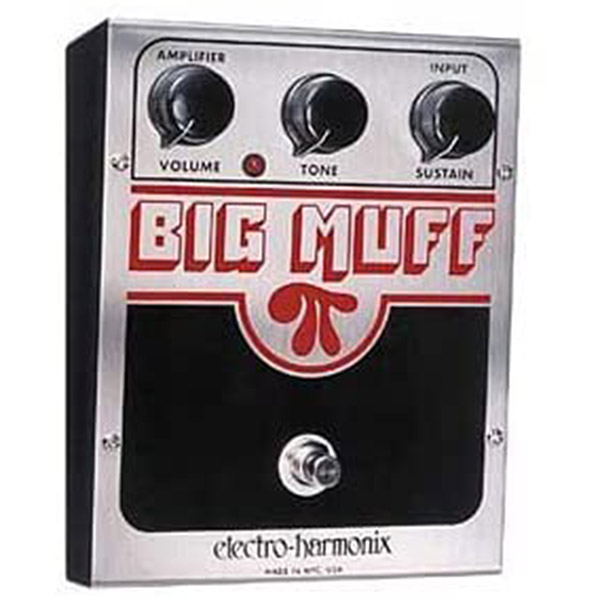
Years Used: Early 2000s to Present
Overview: There’s hardly any distortion pedal out there that’s been produced as long as Electro-Harmonix’s Big Muff Pi. However, Jack White mostly uses the basic version. Although this pedal bears only three basic controls, it’s not that hard to make an abundance of different tones due to its specific circuitry. And pairing it up with a tube amp (which Jack White does all the time) brings even more versatility if you use the full potential of its vacuum tubes.
This rather simple pedal comes with volume, tone, and sustain knobs. While we’re aware of volume and tone (treble roll-off) controls, the sustain knob adds more distortion and more sustain. However, pushing it closer to maximum levels, the sustain control will also add some of that fuzzy rich harmonic content. Big Muff Pi is used by guitar players of many different genres.
Popular Article: Guitars Used by James Hetfield
Electro-Harmonix POG2 Polyphonic Octave Generator
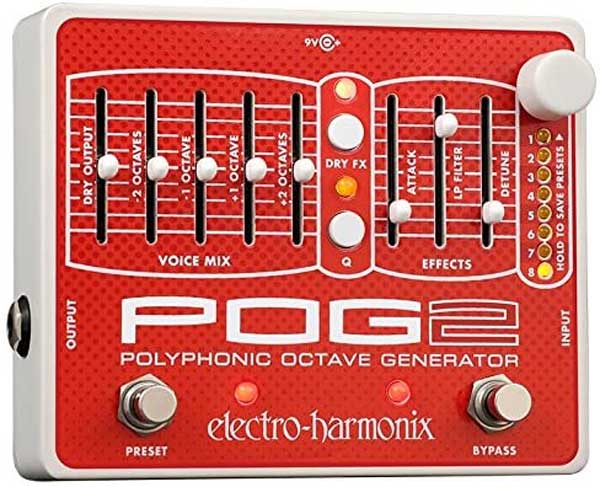
Years Used: 2004 to Present
Overview: Electro-Harmonix has a lot of interesting stuff in their arsenal, and a pedal like POG2, or the Polyphonic Octave Generator, occasionally finds its way into Jack White’s rig. This is basically a synth-like effect that can add one and two octaves above and below what you’re playing. There are also controls for attack, low-pass filter, and detune which creates that “wobbly” tone.
But what’s also exciting is that the pedal is capable of storing 8 different presets on it. You can toggle these 8 presets using the pedal’s secondary footswitch. The resulting tones are pretty useful for lead sections or those beefy one-note riffs, making it all sound as if you’re playing a synth. Pairing it up with the Big Muff Pi pedal, which is what Jack does, can create some pretty crazy harmonically rich tones.
ZVex Woolly Mammoth
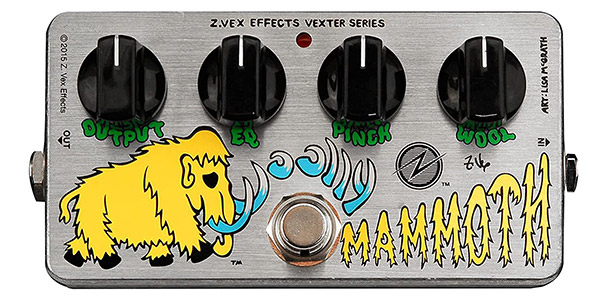
Years Used: 2007 to Present
Overview: While ZVex pedals aren’t as known as some other brands, they are certainly one of the best companies on the market. From their “boutique” quality devices, Jack White prefers to use the Woolly Mammoth fuzz pedal, originally intended for bass guitars.
Once again, we have a fairly simple fuzz device. However, it features four controls, one of them being the “pinch” knob that adds more of those high-ends into the equation. But although the pedal brings a lot of that hard-clipping fuzz into the mix, it’s easy to control your dynamics while playing through it. It comes in handy for both rhythm and lead sections.
Boss TU-2
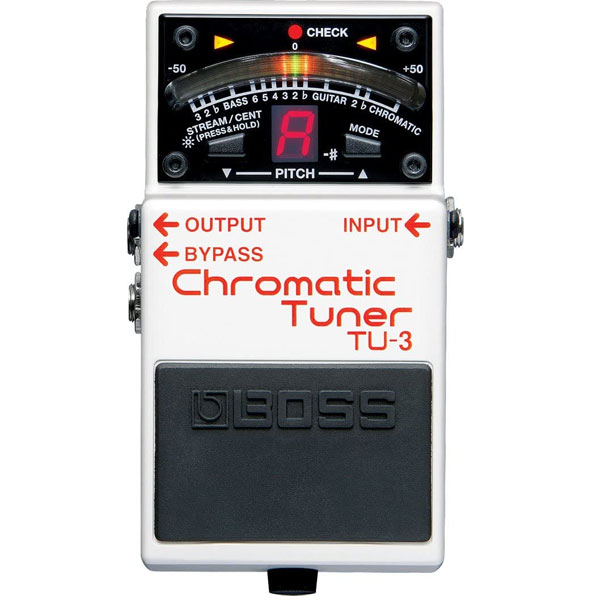
Years Used: 2006 to Present
Overview: Almost every famous guitar player has some Boss devices in their signal chain. Although Jack doesn’t have that many Boss devices, a simple tuner like the company’s TU-2 pedal is most definitely a useful addition. This one is pretty popular among players of all skill levels, mostly due to its simple layout and pretty intuitive design. Its LED lights are pretty easy to spot while you’re playing on stage and need to tune your instrument in between the songs.
However, another thing that makes this pedal pretty popular is its buffered bypass circuitry. While we can spend days discussing whether buffered or true bypass works better, a buffered pedal at the beginning of the signal chain can help you save the quality of your tone.
Eventide H9 Harmonizer
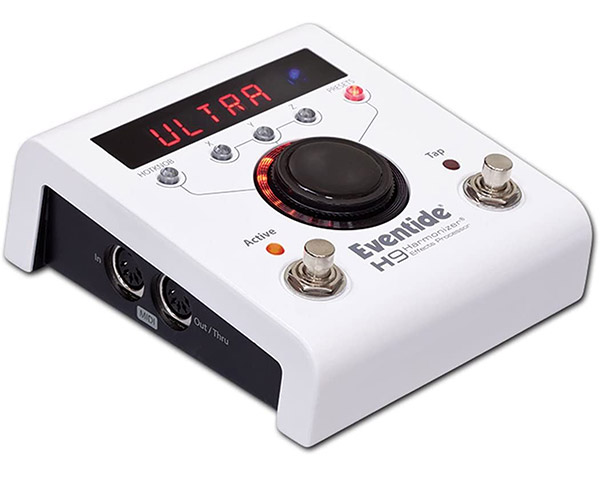
Years Used: 2010 to Present
Overview: It’s not a surprise to see Eventide’s H9 Harmonizer pedal in Jack White’s collection. This one is a fairly potent harmonizer device with a single-knob interface and a pretty decent number of options. But what makes it so special is the Bluetooth connectivity that helps you pair this one with your iOS device and manage all the presets.
Although a compact and simple one, this is a high-end professional device. It not only adds different pitch-shifting effects, but it also comes with other stuff, like choruses, different reverbs different delays, and many other atmospheric and modulation effects.
Gamechanger Audio Third Man Records Plasma Coil
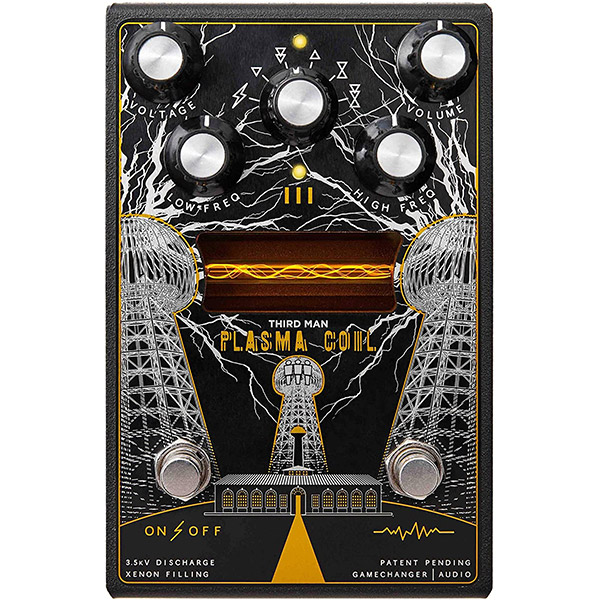
Years Used: 2012 to Present
Overview: While it’s really hard to surprise us with new pedals, the Third Man Records Plasma Coil manages to push the boundaries of conventional guitar playing and effects use. This one combines distortion and octave into one device, creating those rich tones full of delicate harmonic ingredients. Made by Gamechanger Audio, this particular one was made especially according to Jack’s needs.
The craziest thing about it is that the signal is converted into a 3.5k-volt electrical charge and blasted through a xenon-filled tube. The resulting tone is a face-melting distortion that cuts through the mix. With its two sub-octave and one upper-octave mode, this pedal brings a lot of options to the table.
Wrap up
During his work in The White Stripes, a legendary rock duo featuring Meg White on the drums, Jack proved that he’s not only a capable songwriter but also a unique guitar player and singer. Of course, he’s not necessarily known as a guitar virtuoso like one would think of when mentioning great guitar players, but Jack did put a new twist to the instrument and its use in rock music, all while combining it with his incredible songwriting ability. These days you can hear entire sports stadiums chanting the main riff of “Seven Nation Army” in unison.

My name is Chris and I’ve had a passion for music and guitars for as long as I can remember. I started this website with some of my friends who are musicians, music teachers, gear heads, and music enthusiasts so we could provide high-quality guitar and music-related content.
I’ve been playing guitar since I was 13 years old and am an avid collector. Amps, pedals, guitars, bass, drums, microphones, studio, and recording gear, I love it all.
I was born and raised in Western Pennsylvania. My background is in Electrical Engineering, earning a Bachelor’s degree from Youngstown State University. With my engineering experience, I’ve developed as a designer of guitar amplifiers and effects. A true passion of mine, I’ve designed, built, and repaired a wide range of guitar amps and electronics. Here at the Guitar Lobby, our aim is to share our passion for Music and gear with the rest of the music community.
